Slow Food Movement: History, Objectives, and Key Activities Essay
VerifiedAdded on 2023/01/06
|8
|3465
|49
Essay
AI Summary
This essay critically examines the Slow Food Movement in the context of 21st-century food consumption. It begins by outlining the impact of industrialization, urbanization, and globalization on food production and consumption patterns, highlighting the rise of fast food and its negative consequences on the environment, economy, and society. The essay then introduces the Slow Food Movement as a response, emphasizing its historical origins in 1986 and its core philosophy of 'Good, Clean, and Fair food.' It delves into the movement's objectives, including preserving biodiversity, promoting local food cultures, and educating consumers about taste and food production. Key areas of focus, such as producer-consumer interaction and taste education, are explored, along with potential controversies and challenges. The essay concludes by underscoring the movement's efforts to provide an alternative to fast food and promote sustainable food practices.

Slow Food Movement
Paraphrase This Document
Need a fresh take? Get an instant paraphrase of this document with our AI Paraphraser

Table of Contents
ESSAY.......................................................................................................................................3
Using examples, critically discuss what the Slow Food Movement is in relation to food
consumption in the 21st century, its history, and its objectives, key areas of focus,
underlying principles and key activities.................................................................................3
REFERENCES...........................................................................................................................8
Books and journals.................................................................................................................8
ESSAY.......................................................................................................................................3
Using examples, critically discuss what the Slow Food Movement is in relation to food
consumption in the 21st century, its history, and its objectives, key areas of focus,
underlying principles and key activities.................................................................................3
REFERENCES...........................................................................................................................8
Books and journals.................................................................................................................8
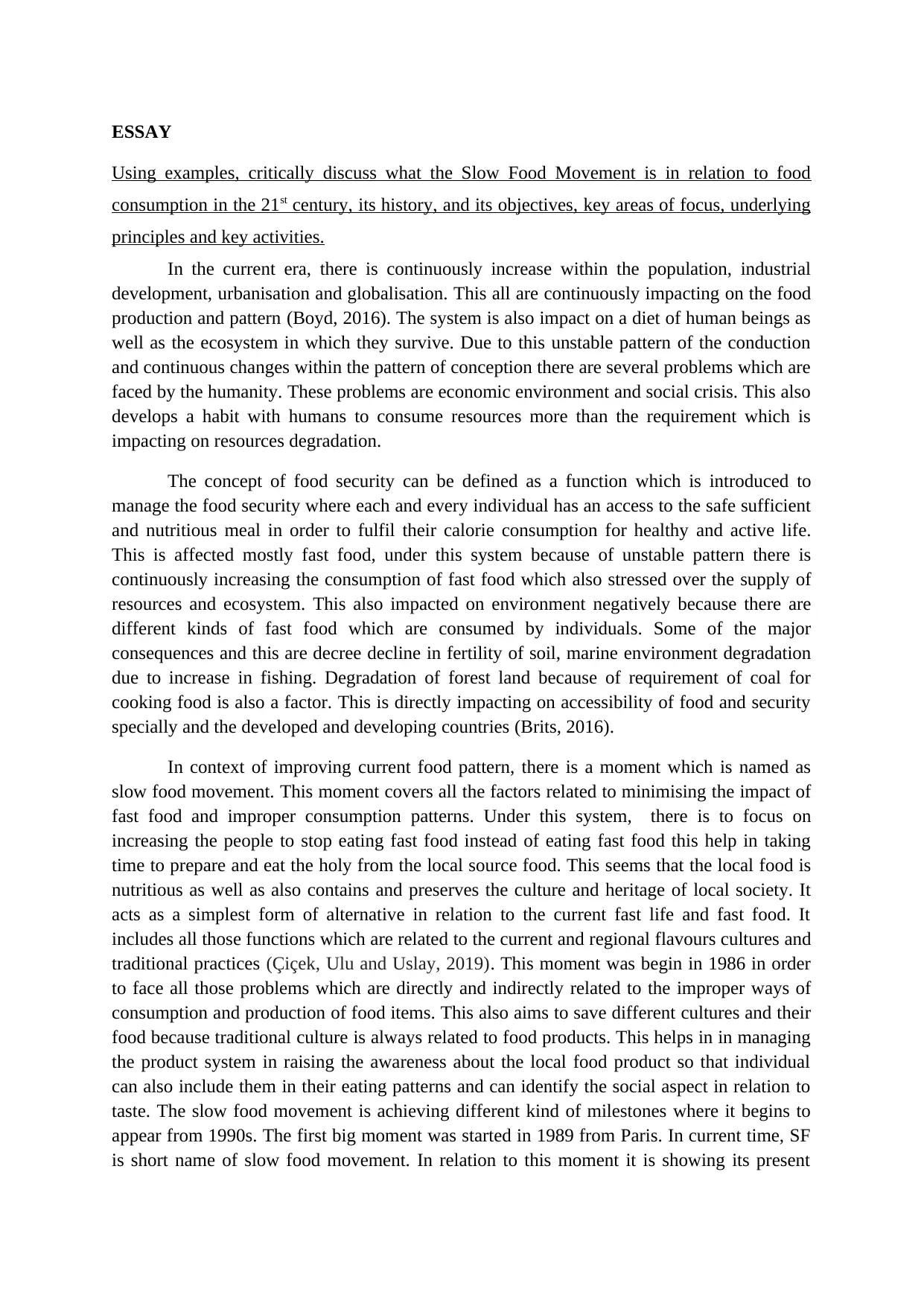
ESSAY
Using examples, critically discuss what the Slow Food Movement is in relation to food
consumption in the 21st century, its history, and its objectives, key areas of focus, underlying
principles and key activities.
In the current era, there is continuously increase within the population, industrial
development, urbanisation and globalisation. This all are continuously impacting on the food
production and pattern (Boyd, 2016). The system is also impact on a diet of human beings as
well as the ecosystem in which they survive. Due to this unstable pattern of the conduction
and continuous changes within the pattern of conception there are several problems which are
faced by the humanity. These problems are economic environment and social crisis. This also
develops a habit with humans to consume resources more than the requirement which is
impacting on resources degradation.
The concept of food security can be defined as a function which is introduced to
manage the food security where each and every individual has an access to the safe sufficient
and nutritious meal in order to fulfil their calorie consumption for healthy and active life.
This is affected mostly fast food, under this system because of unstable pattern there is
continuously increasing the consumption of fast food which also stressed over the supply of
resources and ecosystem. This also impacted on environment negatively because there are
different kinds of fast food which are consumed by individuals. Some of the major
consequences and this are decree decline in fertility of soil, marine environment degradation
due to increase in fishing. Degradation of forest land because of requirement of coal for
cooking food is also a factor. This is directly impacting on accessibility of food and security
specially and the developed and developing countries (Brits, 2016).
In context of improving current food pattern, there is a moment which is named as
slow food movement. This moment covers all the factors related to minimising the impact of
fast food and improper consumption patterns. Under this system, there is to focus on
increasing the people to stop eating fast food instead of eating fast food this help in taking
time to prepare and eat the holy from the local source food. This seems that the local food is
nutritious as well as also contains and preserves the culture and heritage of local society. It
acts as a simplest form of alternative in relation to the current fast life and fast food. It
includes all those functions which are related to the current and regional flavours cultures and
traditional practices (Çiçek, Ulu and Uslay, 2019). This moment was begin in 1986 in order
to face all those problems which are directly and indirectly related to the improper ways of
consumption and production of food items. This also aims to save different cultures and their
food because traditional culture is always related to food products. This helps in in managing
the product system in raising the awareness about the local food product so that individual
can also include them in their eating patterns and can identify the social aspect in relation to
taste. The slow food movement is achieving different kind of milestones where it begins to
appear from 1990s. The first big moment was started in 1989 from Paris. In current time, SF
is short name of slow food movement. In relation to this moment it is showing its present
Using examples, critically discuss what the Slow Food Movement is in relation to food
consumption in the 21st century, its history, and its objectives, key areas of focus, underlying
principles and key activities.
In the current era, there is continuously increase within the population, industrial
development, urbanisation and globalisation. This all are continuously impacting on the food
production and pattern (Boyd, 2016). The system is also impact on a diet of human beings as
well as the ecosystem in which they survive. Due to this unstable pattern of the conduction
and continuous changes within the pattern of conception there are several problems which are
faced by the humanity. These problems are economic environment and social crisis. This also
develops a habit with humans to consume resources more than the requirement which is
impacting on resources degradation.
The concept of food security can be defined as a function which is introduced to
manage the food security where each and every individual has an access to the safe sufficient
and nutritious meal in order to fulfil their calorie consumption for healthy and active life.
This is affected mostly fast food, under this system because of unstable pattern there is
continuously increasing the consumption of fast food which also stressed over the supply of
resources and ecosystem. This also impacted on environment negatively because there are
different kinds of fast food which are consumed by individuals. Some of the major
consequences and this are decree decline in fertility of soil, marine environment degradation
due to increase in fishing. Degradation of forest land because of requirement of coal for
cooking food is also a factor. This is directly impacting on accessibility of food and security
specially and the developed and developing countries (Brits, 2016).
In context of improving current food pattern, there is a moment which is named as
slow food movement. This moment covers all the factors related to minimising the impact of
fast food and improper consumption patterns. Under this system, there is to focus on
increasing the people to stop eating fast food instead of eating fast food this help in taking
time to prepare and eat the holy from the local source food. This seems that the local food is
nutritious as well as also contains and preserves the culture and heritage of local society. It
acts as a simplest form of alternative in relation to the current fast life and fast food. It
includes all those functions which are related to the current and regional flavours cultures and
traditional practices (Çiçek, Ulu and Uslay, 2019). This moment was begin in 1986 in order
to face all those problems which are directly and indirectly related to the improper ways of
consumption and production of food items. This also aims to save different cultures and their
food because traditional culture is always related to food products. This helps in in managing
the product system in raising the awareness about the local food product so that individual
can also include them in their eating patterns and can identify the social aspect in relation to
taste. The slow food movement is achieving different kind of milestones where it begins to
appear from 1990s. The first big moment was started in 1989 from Paris. In current time, SF
is short name of slow food movement. In relation to this moment it is showing its present
⊘ This is a preview!⊘
Do you want full access?
Subscribe today to unlock all pages.

Trusted by 1+ million students worldwide
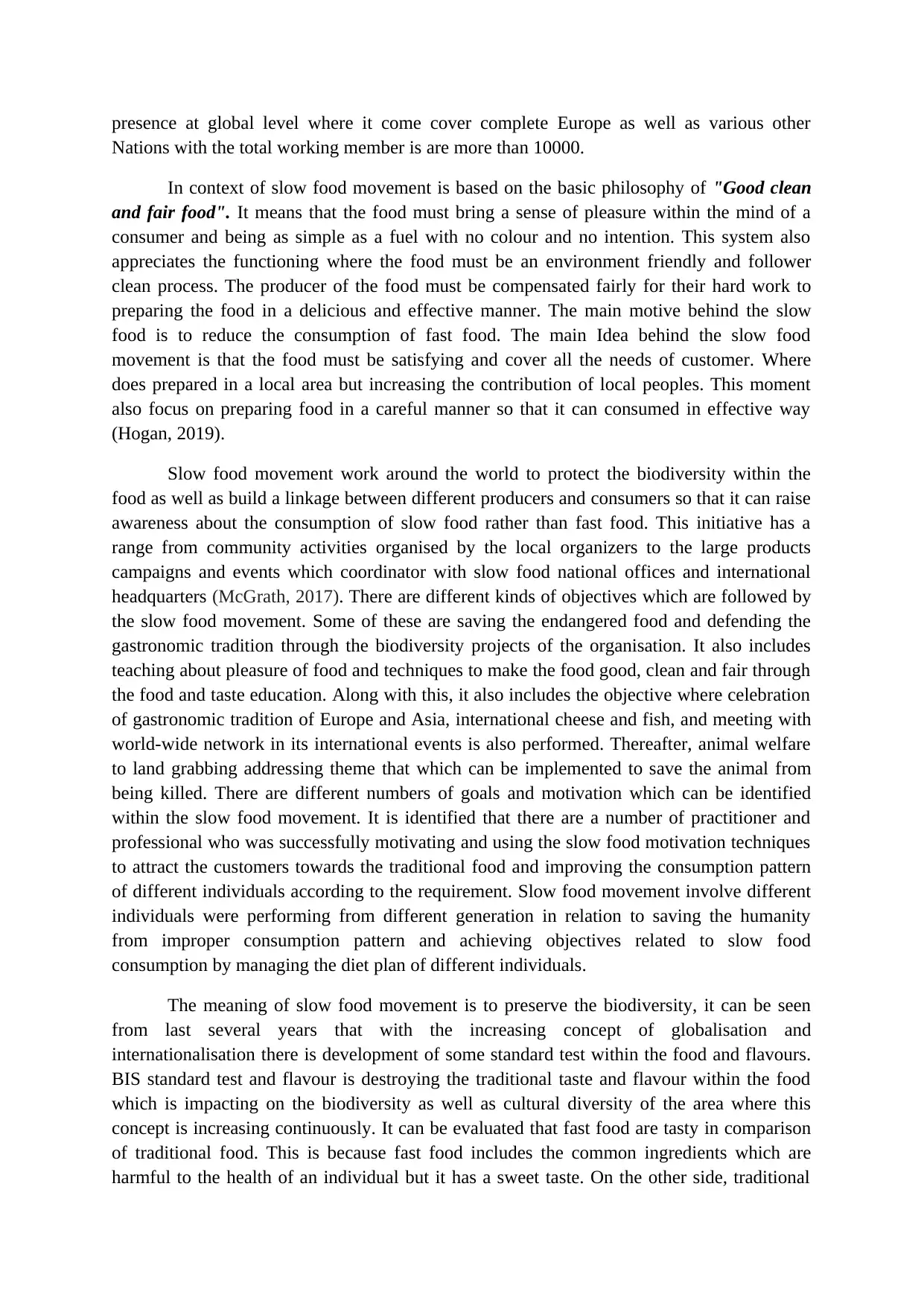
presence at global level where it come cover complete Europe as well as various other
Nations with the total working member is are more than 10000.
In context of slow food movement is based on the basic philosophy of "Good clean
and fair food". It means that the food must bring a sense of pleasure within the mind of a
consumer and being as simple as a fuel with no colour and no intention. This system also
appreciates the functioning where the food must be an environment friendly and follower
clean process. The producer of the food must be compensated fairly for their hard work to
preparing the food in a delicious and effective manner. The main motive behind the slow
food is to reduce the consumption of fast food. The main Idea behind the slow food
movement is that the food must be satisfying and cover all the needs of customer. Where
does prepared in a local area but increasing the contribution of local peoples. This moment
also focus on preparing food in a careful manner so that it can consumed in effective way
(Hogan, 2019).
Slow food movement work around the world to protect the biodiversity within the
food as well as build a linkage between different producers and consumers so that it can raise
awareness about the consumption of slow food rather than fast food. This initiative has a
range from community activities organised by the local organizers to the large products
campaigns and events which coordinator with slow food national offices and international
headquarters (McGrath, 2017). There are different kinds of objectives which are followed by
the slow food movement. Some of these are saving the endangered food and defending the
gastronomic tradition through the biodiversity projects of the organisation. It also includes
teaching about pleasure of food and techniques to make the food good, clean and fair through
the food and taste education. Along with this, it also includes the objective where celebration
of gastronomic tradition of Europe and Asia, international cheese and fish, and meeting with
world-wide network in its international events is also performed. Thereafter, animal welfare
to land grabbing addressing theme that which can be implemented to save the animal from
being killed. There are different numbers of goals and motivation which can be identified
within the slow food movement. It is identified that there are a number of practitioner and
professional who was successfully motivating and using the slow food motivation techniques
to attract the customers towards the traditional food and improving the consumption pattern
of different individuals according to the requirement. Slow food movement involve different
individuals were performing from different generation in relation to saving the humanity
from improper consumption pattern and achieving objectives related to slow food
consumption by managing the diet plan of different individuals.
The meaning of slow food movement is to preserve the biodiversity, it can be seen
from last several years that with the increasing concept of globalisation and
internationalisation there is development of some standard test within the food and flavours.
BIS standard test and flavour is destroying the traditional taste and flavour within the food
which is impacting on the biodiversity as well as cultural diversity of the area where this
concept is increasing continuously. It can be evaluated that fast food are tasty in comparison
of traditional food. This is because fast food includes the common ingredients which are
harmful to the health of an individual but it has a sweet taste. On the other side, traditional
Nations with the total working member is are more than 10000.
In context of slow food movement is based on the basic philosophy of "Good clean
and fair food". It means that the food must bring a sense of pleasure within the mind of a
consumer and being as simple as a fuel with no colour and no intention. This system also
appreciates the functioning where the food must be an environment friendly and follower
clean process. The producer of the food must be compensated fairly for their hard work to
preparing the food in a delicious and effective manner. The main motive behind the slow
food is to reduce the consumption of fast food. The main Idea behind the slow food
movement is that the food must be satisfying and cover all the needs of customer. Where
does prepared in a local area but increasing the contribution of local peoples. This moment
also focus on preparing food in a careful manner so that it can consumed in effective way
(Hogan, 2019).
Slow food movement work around the world to protect the biodiversity within the
food as well as build a linkage between different producers and consumers so that it can raise
awareness about the consumption of slow food rather than fast food. This initiative has a
range from community activities organised by the local organizers to the large products
campaigns and events which coordinator with slow food national offices and international
headquarters (McGrath, 2017). There are different kinds of objectives which are followed by
the slow food movement. Some of these are saving the endangered food and defending the
gastronomic tradition through the biodiversity projects of the organisation. It also includes
teaching about pleasure of food and techniques to make the food good, clean and fair through
the food and taste education. Along with this, it also includes the objective where celebration
of gastronomic tradition of Europe and Asia, international cheese and fish, and meeting with
world-wide network in its international events is also performed. Thereafter, animal welfare
to land grabbing addressing theme that which can be implemented to save the animal from
being killed. There are different numbers of goals and motivation which can be identified
within the slow food movement. It is identified that there are a number of practitioner and
professional who was successfully motivating and using the slow food motivation techniques
to attract the customers towards the traditional food and improving the consumption pattern
of different individuals according to the requirement. Slow food movement involve different
individuals were performing from different generation in relation to saving the humanity
from improper consumption pattern and achieving objectives related to slow food
consumption by managing the diet plan of different individuals.
The meaning of slow food movement is to preserve the biodiversity, it can be seen
from last several years that with the increasing concept of globalisation and
internationalisation there is development of some standard test within the food and flavours.
BIS standard test and flavour is destroying the traditional taste and flavour within the food
which is impacting on the biodiversity as well as cultural diversity of the area where this
concept is increasing continuously. It can be evaluated that fast food are tasty in comparison
of traditional food. This is because fast food includes the common ingredients which are
harmful to the health of an individual but it has a sweet taste. On the other side, traditional
Paraphrase This Document
Need a fresh take? Get an instant paraphrase of this document with our AI Paraphraser
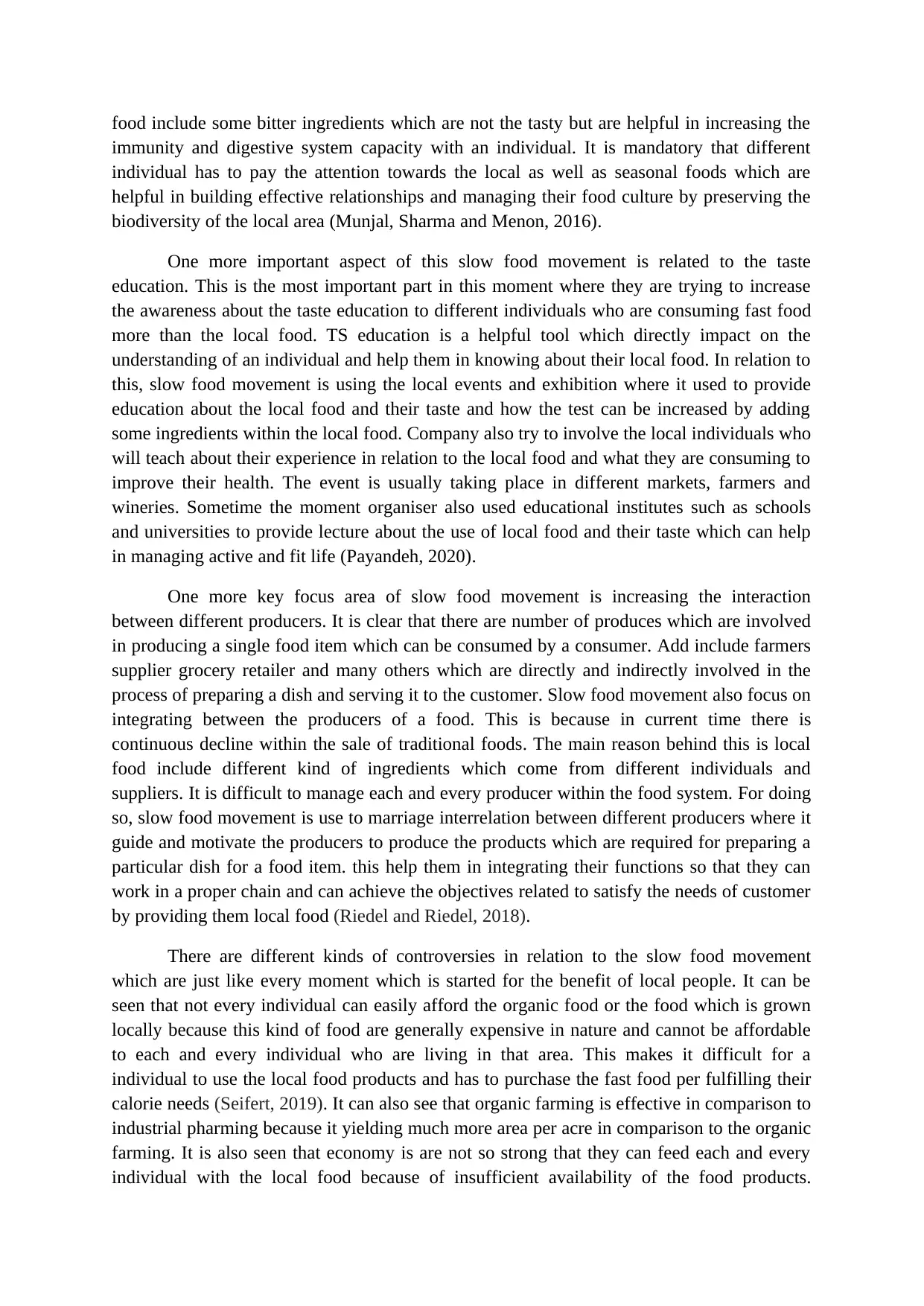
food include some bitter ingredients which are not the tasty but are helpful in increasing the
immunity and digestive system capacity with an individual. It is mandatory that different
individual has to pay the attention towards the local as well as seasonal foods which are
helpful in building effective relationships and managing their food culture by preserving the
biodiversity of the local area (Munjal, Sharma and Menon, 2016).
One more important aspect of this slow food movement is related to the taste
education. This is the most important part in this moment where they are trying to increase
the awareness about the taste education to different individuals who are consuming fast food
more than the local food. TS education is a helpful tool which directly impact on the
understanding of an individual and help them in knowing about their local food. In relation to
this, slow food movement is using the local events and exhibition where it used to provide
education about the local food and their taste and how the test can be increased by adding
some ingredients within the local food. Company also try to involve the local individuals who
will teach about their experience in relation to the local food and what they are consuming to
improve their health. The event is usually taking place in different markets, farmers and
wineries. Sometime the moment organiser also used educational institutes such as schools
and universities to provide lecture about the use of local food and their taste which can help
in managing active and fit life (Payandeh, 2020).
One more key focus area of slow food movement is increasing the interaction
between different producers. It is clear that there are number of produces which are involved
in producing a single food item which can be consumed by a consumer. Add include farmers
supplier grocery retailer and many others which are directly and indirectly involved in the
process of preparing a dish and serving it to the customer. Slow food movement also focus on
integrating between the producers of a food. This is because in current time there is
continuous decline within the sale of traditional foods. The main reason behind this is local
food include different kind of ingredients which come from different individuals and
suppliers. It is difficult to manage each and every producer within the food system. For doing
so, slow food movement is use to marriage interrelation between different producers where it
guide and motivate the producers to produce the products which are required for preparing a
particular dish for a food item. this help them in integrating their functions so that they can
work in a proper chain and can achieve the objectives related to satisfy the needs of customer
by providing them local food (Riedel and Riedel, 2018).
There are different kinds of controversies in relation to the slow food movement
which are just like every moment which is started for the benefit of local people. It can be
seen that not every individual can easily afford the organic food or the food which is grown
locally because this kind of food are generally expensive in nature and cannot be affordable
to each and every individual who are living in that area. This makes it difficult for a
individual to use the local food products and has to purchase the fast food per fulfilling their
calorie needs (Seifert, 2019). It can also see that organic farming is effective in comparison to
industrial pharming because it yielding much more area per acre in comparison to the organic
farming. It is also seen that economy is are not so strong that they can feed each and every
individual with the local food because of insufficient availability of the food products.
immunity and digestive system capacity with an individual. It is mandatory that different
individual has to pay the attention towards the local as well as seasonal foods which are
helpful in building effective relationships and managing their food culture by preserving the
biodiversity of the local area (Munjal, Sharma and Menon, 2016).
One more important aspect of this slow food movement is related to the taste
education. This is the most important part in this moment where they are trying to increase
the awareness about the taste education to different individuals who are consuming fast food
more than the local food. TS education is a helpful tool which directly impact on the
understanding of an individual and help them in knowing about their local food. In relation to
this, slow food movement is using the local events and exhibition where it used to provide
education about the local food and their taste and how the test can be increased by adding
some ingredients within the local food. Company also try to involve the local individuals who
will teach about their experience in relation to the local food and what they are consuming to
improve their health. The event is usually taking place in different markets, farmers and
wineries. Sometime the moment organiser also used educational institutes such as schools
and universities to provide lecture about the use of local food and their taste which can help
in managing active and fit life (Payandeh, 2020).
One more key focus area of slow food movement is increasing the interaction
between different producers. It is clear that there are number of produces which are involved
in producing a single food item which can be consumed by a consumer. Add include farmers
supplier grocery retailer and many others which are directly and indirectly involved in the
process of preparing a dish and serving it to the customer. Slow food movement also focus on
integrating between the producers of a food. This is because in current time there is
continuous decline within the sale of traditional foods. The main reason behind this is local
food include different kind of ingredients which come from different individuals and
suppliers. It is difficult to manage each and every producer within the food system. For doing
so, slow food movement is use to marriage interrelation between different producers where it
guide and motivate the producers to produce the products which are required for preparing a
particular dish for a food item. this help them in integrating their functions so that they can
work in a proper chain and can achieve the objectives related to satisfy the needs of customer
by providing them local food (Riedel and Riedel, 2018).
There are different kinds of controversies in relation to the slow food movement
which are just like every moment which is started for the benefit of local people. It can be
seen that not every individual can easily afford the organic food or the food which is grown
locally because this kind of food are generally expensive in nature and cannot be affordable
to each and every individual who are living in that area. This makes it difficult for a
individual to use the local food products and has to purchase the fast food per fulfilling their
calorie needs (Seifert, 2019). It can also see that organic farming is effective in comparison to
industrial pharming because it yielding much more area per acre in comparison to the organic
farming. It is also seen that economy is are not so strong that they can feed each and every
individual with the local food because of insufficient availability of the food products.
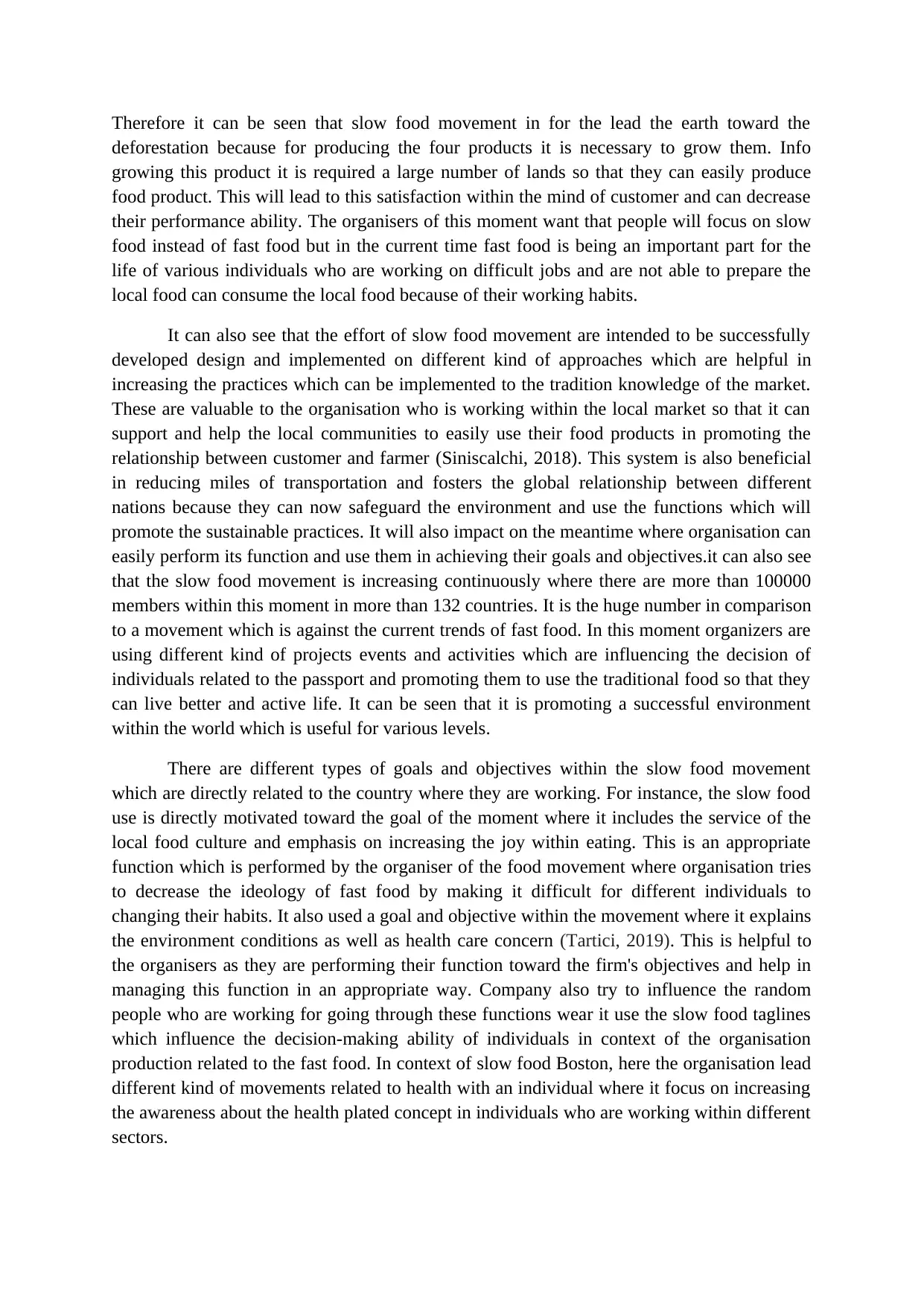
Therefore it can be seen that slow food movement in for the lead the earth toward the
deforestation because for producing the four products it is necessary to grow them. Info
growing this product it is required a large number of lands so that they can easily produce
food product. This will lead to this satisfaction within the mind of customer and can decrease
their performance ability. The organisers of this moment want that people will focus on slow
food instead of fast food but in the current time fast food is being an important part for the
life of various individuals who are working on difficult jobs and are not able to prepare the
local food can consume the local food because of their working habits.
It can also see that the effort of slow food movement are intended to be successfully
developed design and implemented on different kind of approaches which are helpful in
increasing the practices which can be implemented to the tradition knowledge of the market.
These are valuable to the organisation who is working within the local market so that it can
support and help the local communities to easily use their food products in promoting the
relationship between customer and farmer (Siniscalchi, 2018). This system is also beneficial
in reducing miles of transportation and fosters the global relationship between different
nations because they can now safeguard the environment and use the functions which will
promote the sustainable practices. It will also impact on the meantime where organisation can
easily perform its function and use them in achieving their goals and objectives.it can also see
that the slow food movement is increasing continuously where there are more than 100000
members within this moment in more than 132 countries. It is the huge number in comparison
to a movement which is against the current trends of fast food. In this moment organizers are
using different kind of projects events and activities which are influencing the decision of
individuals related to the passport and promoting them to use the traditional food so that they
can live better and active life. It can be seen that it is promoting a successful environment
within the world which is useful for various levels.
There are different types of goals and objectives within the slow food movement
which are directly related to the country where they are working. For instance, the slow food
use is directly motivated toward the goal of the moment where it includes the service of the
local food culture and emphasis on increasing the joy within eating. This is an appropriate
function which is performed by the organiser of the food movement where organisation tries
to decrease the ideology of fast food by making it difficult for different individuals to
changing their habits. It also used a goal and objective within the movement where it explains
the environment conditions as well as health care concern (Tartici, 2019). This is helpful to
the organisers as they are performing their function toward the firm's objectives and help in
managing this function in an appropriate way. Company also try to influence the random
people who are working for going through these functions wear it use the slow food taglines
which influence the decision-making ability of individuals in context of the organisation
production related to the fast food. In context of slow food Boston, here the organisation lead
different kind of movements related to health with an individual where it focus on increasing
the awareness about the health plated concept in individuals who are working within different
sectors.
deforestation because for producing the four products it is necessary to grow them. Info
growing this product it is required a large number of lands so that they can easily produce
food product. This will lead to this satisfaction within the mind of customer and can decrease
their performance ability. The organisers of this moment want that people will focus on slow
food instead of fast food but in the current time fast food is being an important part for the
life of various individuals who are working on difficult jobs and are not able to prepare the
local food can consume the local food because of their working habits.
It can also see that the effort of slow food movement are intended to be successfully
developed design and implemented on different kind of approaches which are helpful in
increasing the practices which can be implemented to the tradition knowledge of the market.
These are valuable to the organisation who is working within the local market so that it can
support and help the local communities to easily use their food products in promoting the
relationship between customer and farmer (Siniscalchi, 2018). This system is also beneficial
in reducing miles of transportation and fosters the global relationship between different
nations because they can now safeguard the environment and use the functions which will
promote the sustainable practices. It will also impact on the meantime where organisation can
easily perform its function and use them in achieving their goals and objectives.it can also see
that the slow food movement is increasing continuously where there are more than 100000
members within this moment in more than 132 countries. It is the huge number in comparison
to a movement which is against the current trends of fast food. In this moment organizers are
using different kind of projects events and activities which are influencing the decision of
individuals related to the passport and promoting them to use the traditional food so that they
can live better and active life. It can be seen that it is promoting a successful environment
within the world which is useful for various levels.
There are different types of goals and objectives within the slow food movement
which are directly related to the country where they are working. For instance, the slow food
use is directly motivated toward the goal of the moment where it includes the service of the
local food culture and emphasis on increasing the joy within eating. This is an appropriate
function which is performed by the organiser of the food movement where organisation tries
to decrease the ideology of fast food by making it difficult for different individuals to
changing their habits. It also used a goal and objective within the movement where it explains
the environment conditions as well as health care concern (Tartici, 2019). This is helpful to
the organisers as they are performing their function toward the firm's objectives and help in
managing this function in an appropriate way. Company also try to influence the random
people who are working for going through these functions wear it use the slow food taglines
which influence the decision-making ability of individuals in context of the organisation
production related to the fast food. In context of slow food Boston, here the organisation lead
different kind of movements related to health with an individual where it focus on increasing
the awareness about the health plated concept in individuals who are working within different
sectors.
⊘ This is a preview!⊘
Do you want full access?
Subscribe today to unlock all pages.

Trusted by 1+ million students worldwide
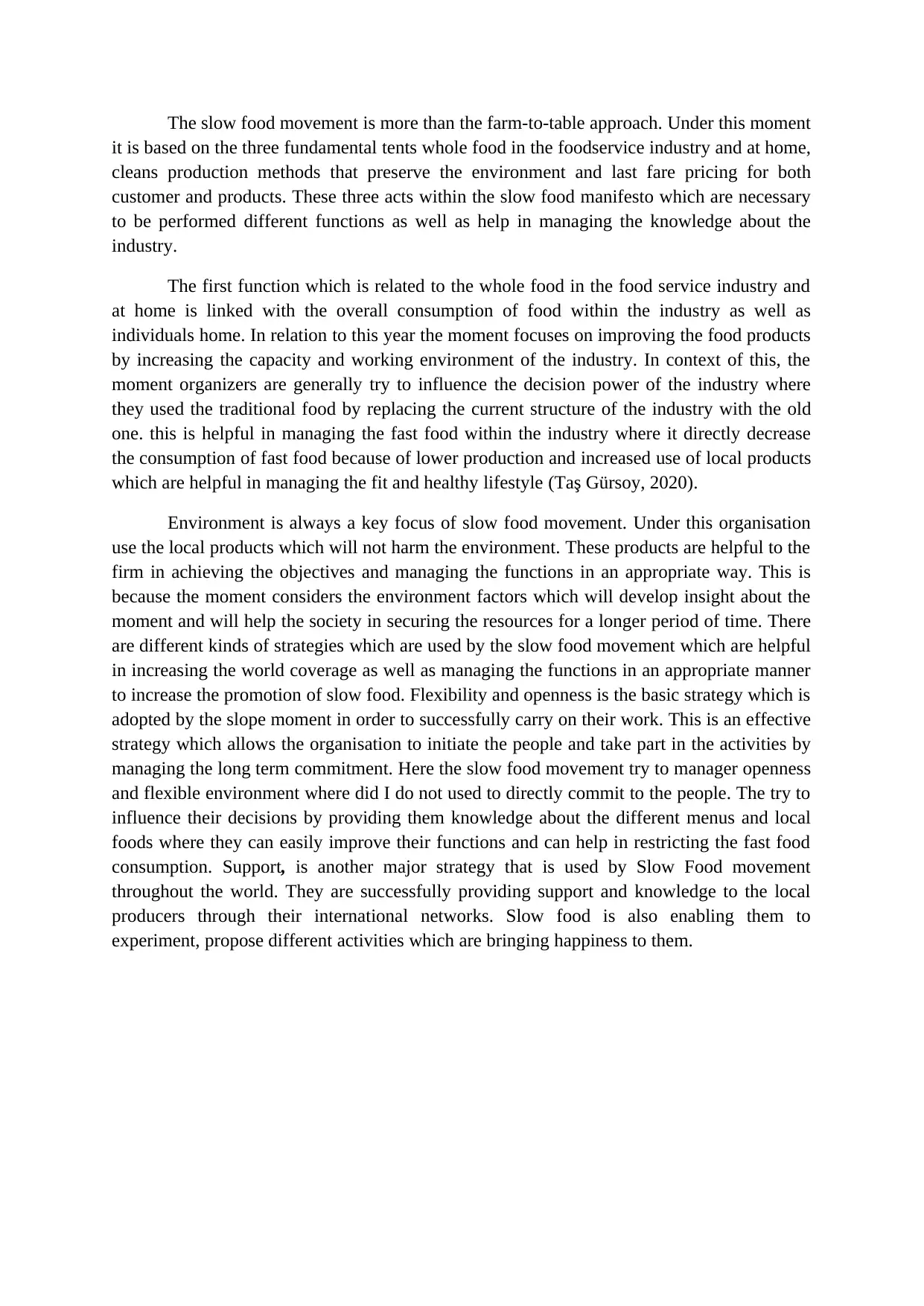
The slow food movement is more than the farm-to-table approach. Under this moment
it is based on the three fundamental tents whole food in the foodservice industry and at home,
cleans production methods that preserve the environment and last fare pricing for both
customer and products. These three acts within the slow food manifesto which are necessary
to be performed different functions as well as help in managing the knowledge about the
industry.
The first function which is related to the whole food in the food service industry and
at home is linked with the overall consumption of food within the industry as well as
individuals home. In relation to this year the moment focuses on improving the food products
by increasing the capacity and working environment of the industry. In context of this, the
moment organizers are generally try to influence the decision power of the industry where
they used the traditional food by replacing the current structure of the industry with the old
one. this is helpful in managing the fast food within the industry where it directly decrease
the consumption of fast food because of lower production and increased use of local products
which are helpful in managing the fit and healthy lifestyle (Taş Gürsoy, 2020).
Environment is always a key focus of slow food movement. Under this organisation
use the local products which will not harm the environment. These products are helpful to the
firm in achieving the objectives and managing the functions in an appropriate way. This is
because the moment considers the environment factors which will develop insight about the
moment and will help the society in securing the resources for a longer period of time. There
are different kinds of strategies which are used by the slow food movement which are helpful
in increasing the world coverage as well as managing the functions in an appropriate manner
to increase the promotion of slow food. Flexibility and openness is the basic strategy which is
adopted by the slope moment in order to successfully carry on their work. This is an effective
strategy which allows the organisation to initiate the people and take part in the activities by
managing the long term commitment. Here the slow food movement try to manager openness
and flexible environment where did I do not used to directly commit to the people. The try to
influence their decisions by providing them knowledge about the different menus and local
foods where they can easily improve their functions and can help in restricting the fast food
consumption. Support, is another major strategy that is used by Slow Food movement
throughout the world. They are successfully providing support and knowledge to the local
producers through their international networks. Slow food is also enabling them to
experiment, propose different activities which are bringing happiness to them.
it is based on the three fundamental tents whole food in the foodservice industry and at home,
cleans production methods that preserve the environment and last fare pricing for both
customer and products. These three acts within the slow food manifesto which are necessary
to be performed different functions as well as help in managing the knowledge about the
industry.
The first function which is related to the whole food in the food service industry and
at home is linked with the overall consumption of food within the industry as well as
individuals home. In relation to this year the moment focuses on improving the food products
by increasing the capacity and working environment of the industry. In context of this, the
moment organizers are generally try to influence the decision power of the industry where
they used the traditional food by replacing the current structure of the industry with the old
one. this is helpful in managing the fast food within the industry where it directly decrease
the consumption of fast food because of lower production and increased use of local products
which are helpful in managing the fit and healthy lifestyle (Taş Gürsoy, 2020).
Environment is always a key focus of slow food movement. Under this organisation
use the local products which will not harm the environment. These products are helpful to the
firm in achieving the objectives and managing the functions in an appropriate way. This is
because the moment considers the environment factors which will develop insight about the
moment and will help the society in securing the resources for a longer period of time. There
are different kinds of strategies which are used by the slow food movement which are helpful
in increasing the world coverage as well as managing the functions in an appropriate manner
to increase the promotion of slow food. Flexibility and openness is the basic strategy which is
adopted by the slope moment in order to successfully carry on their work. This is an effective
strategy which allows the organisation to initiate the people and take part in the activities by
managing the long term commitment. Here the slow food movement try to manager openness
and flexible environment where did I do not used to directly commit to the people. The try to
influence their decisions by providing them knowledge about the different menus and local
foods where they can easily improve their functions and can help in restricting the fast food
consumption. Support, is another major strategy that is used by Slow Food movement
throughout the world. They are successfully providing support and knowledge to the local
producers through their international networks. Slow food is also enabling them to
experiment, propose different activities which are bringing happiness to them.
Paraphrase This Document
Need a fresh take? Get an instant paraphrase of this document with our AI Paraphraser
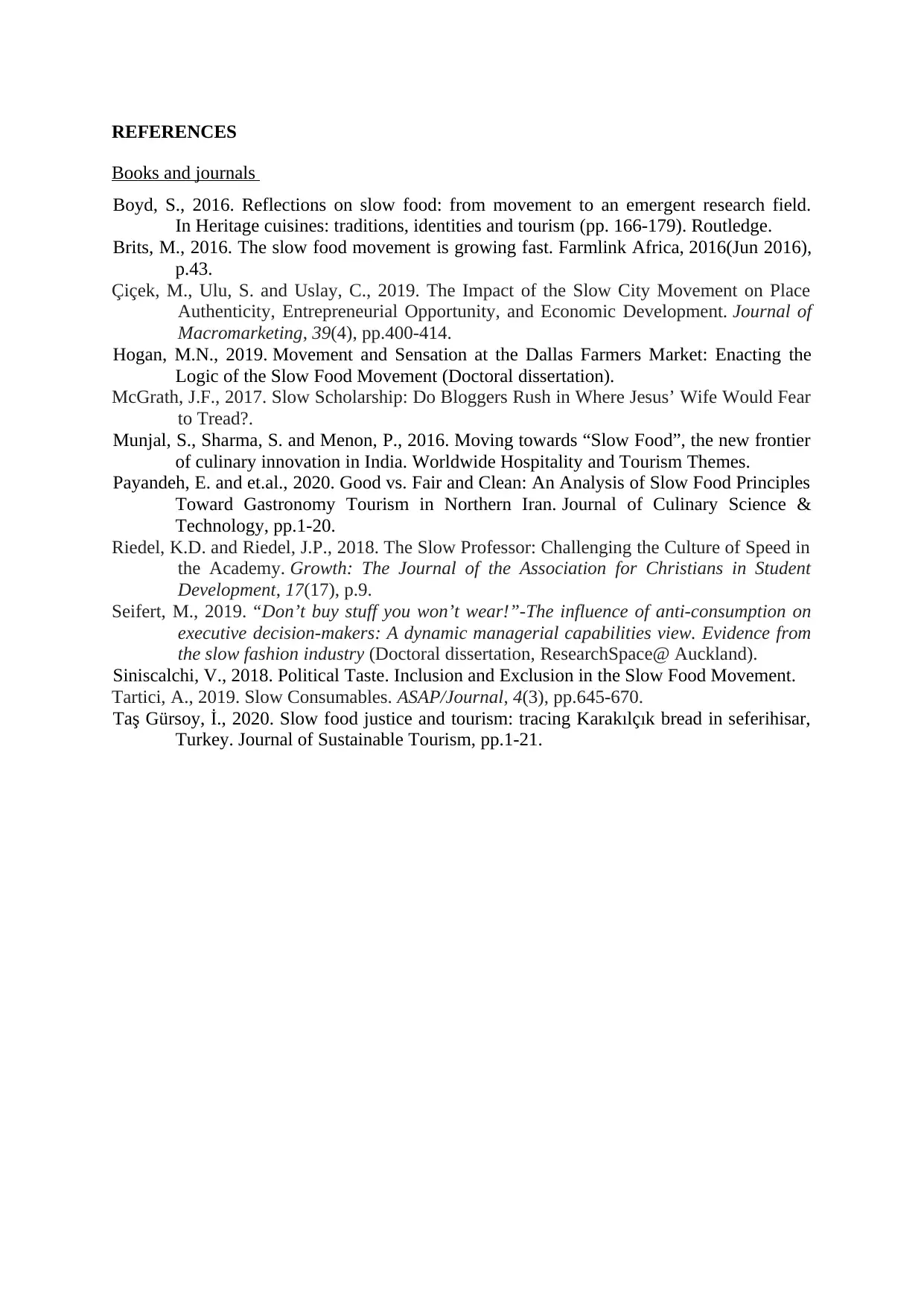
REFERENCES
Books and journals
Boyd, S., 2016. Reflections on slow food: from movement to an emergent research field.
In Heritage cuisines: traditions, identities and tourism (pp. 166-179). Routledge.
Brits, M., 2016. The slow food movement is growing fast. Farmlink Africa, 2016(Jun 2016),
p.43.
Çiçek, M., Ulu, S. and Uslay, C., 2019. The Impact of the Slow City Movement on Place
Authenticity, Entrepreneurial Opportunity, and Economic Development. Journal of
Macromarketing, 39(4), pp.400-414.
Hogan, M.N., 2019. Movement and Sensation at the Dallas Farmers Market: Enacting the
Logic of the Slow Food Movement (Doctoral dissertation).
McGrath, J.F., 2017. Slow Scholarship: Do Bloggers Rush in Where Jesus’ Wife Would Fear
to Tread?.
Munjal, S., Sharma, S. and Menon, P., 2016. Moving towards “Slow Food”, the new frontier
of culinary innovation in India. Worldwide Hospitality and Tourism Themes.
Payandeh, E. and et.al., 2020. Good vs. Fair and Clean: An Analysis of Slow Food Principles
Toward Gastronomy Tourism in Northern Iran. Journal of Culinary Science &
Technology, pp.1-20.
Riedel, K.D. and Riedel, J.P., 2018. The Slow Professor: Challenging the Culture of Speed in
the Academy. Growth: The Journal of the Association for Christians in Student
Development, 17(17), p.9.
Seifert, M., 2019. “Don’t buy stuff you won’t wear!”-The influence of anti-consumption on
executive decision-makers: A dynamic managerial capabilities view. Evidence from
the slow fashion industry (Doctoral dissertation, ResearchSpace@ Auckland).
Siniscalchi, V., 2018. Political Taste. Inclusion and Exclusion in the Slow Food Movement.
Tartici, A., 2019. Slow Consumables. ASAP/Journal, 4(3), pp.645-670.
Taş Gürsoy, İ., 2020. Slow food justice and tourism: tracing Karakılçık bread in seferihisar,
Turkey. Journal of Sustainable Tourism, pp.1-21.
Books and journals
Boyd, S., 2016. Reflections on slow food: from movement to an emergent research field.
In Heritage cuisines: traditions, identities and tourism (pp. 166-179). Routledge.
Brits, M., 2016. The slow food movement is growing fast. Farmlink Africa, 2016(Jun 2016),
p.43.
Çiçek, M., Ulu, S. and Uslay, C., 2019. The Impact of the Slow City Movement on Place
Authenticity, Entrepreneurial Opportunity, and Economic Development. Journal of
Macromarketing, 39(4), pp.400-414.
Hogan, M.N., 2019. Movement and Sensation at the Dallas Farmers Market: Enacting the
Logic of the Slow Food Movement (Doctoral dissertation).
McGrath, J.F., 2017. Slow Scholarship: Do Bloggers Rush in Where Jesus’ Wife Would Fear
to Tread?.
Munjal, S., Sharma, S. and Menon, P., 2016. Moving towards “Slow Food”, the new frontier
of culinary innovation in India. Worldwide Hospitality and Tourism Themes.
Payandeh, E. and et.al., 2020. Good vs. Fair and Clean: An Analysis of Slow Food Principles
Toward Gastronomy Tourism in Northern Iran. Journal of Culinary Science &
Technology, pp.1-20.
Riedel, K.D. and Riedel, J.P., 2018. The Slow Professor: Challenging the Culture of Speed in
the Academy. Growth: The Journal of the Association for Christians in Student
Development, 17(17), p.9.
Seifert, M., 2019. “Don’t buy stuff you won’t wear!”-The influence of anti-consumption on
executive decision-makers: A dynamic managerial capabilities view. Evidence from
the slow fashion industry (Doctoral dissertation, ResearchSpace@ Auckland).
Siniscalchi, V., 2018. Political Taste. Inclusion and Exclusion in the Slow Food Movement.
Tartici, A., 2019. Slow Consumables. ASAP/Journal, 4(3), pp.645-670.
Taş Gürsoy, İ., 2020. Slow food justice and tourism: tracing Karakılçık bread in seferihisar,
Turkey. Journal of Sustainable Tourism, pp.1-21.
1 out of 8
Related Documents
Your All-in-One AI-Powered Toolkit for Academic Success.
+13062052269
info@desklib.com
Available 24*7 on WhatsApp / Email
![[object Object]](/_next/static/media/star-bottom.7253800d.svg)
Unlock your academic potential
Copyright © 2020–2025 A2Z Services. All Rights Reserved. Developed and managed by ZUCOL.





